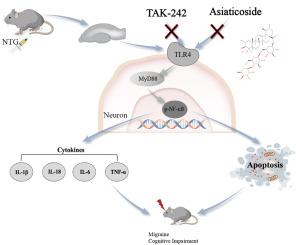积雪草苷通过tlr4介导的细胞凋亡调节缓解偏头痛引起的认知障碍。
IF 4.7
3区 医学
Q1 PHARMACOLOGY & PHARMACY
引用次数: 0
摘要
偏头痛是一种常见的神经系统疾病,常伴有认知障碍,严重降低患者的生活质量。本研究探讨了积雪草中提取的神经保护化合物积雪草苷在缓解偏头痛相关认知缺陷方面的治疗潜力。利用网络药理学,我们确定了积雪草苷的假定分子靶点,并将其与GeneCards和OMIM数据库中的偏头痛和认知障碍相关靶点进行交叉比对。构建蛋白-蛋白相互作用网络,然后进行基因本体和京都基因与基因组百科全书路径富集分析。使用硝酸甘油(NTG)诱导的偏头痛小鼠模型进行体内验证,结合行为评估以及生化和分子分析。网络分析表明TLR4信号通路和细胞凋亡是积雪草苷治疗作用的关键机制。一致地,积雪草苷剂量依赖性地减轻了ntg诱导的伤害性超敏反应和认知障碍。机制上,积雪皂苷显著抑制TLR4-MyD88-NF-κB信号级联,降低脊髓三叉神经尾核、前额叶皮层和海马中促炎细胞因子和CGRP的表达。此外,积雪草苷通过调节BCL-2家族蛋白的平衡和抑制Caspase-3的激活来减轻神经元凋亡。TLR4抑制剂TAK-242的联合使用进一步增强了积雪草苷的保护作用。这些发现共同支持积雪草苷通过调节tlr4介导的神经炎症和细胞凋亡来减轻偏头痛引起的认知障碍,突出了其作为偏头痛及其相关认知障碍的潜在治疗药物的前景。本文章由计算机程序翻译,如有差异,请以英文原文为准。

Asiaticoside alleviates migraine-induced cognitive impairment via TLR4-Mediated apoptosis regulation
Migraine, a prevalent neurological disorder, is often accompanied by cognitive impairment that significantly reduces patients' quality of life. This study explored the therapeutic potential of Asiaticoside, a neuroprotective compound derived from Centella asiatica, in alleviating migraine-associated cognitive deficits. Using network pharmacology, we identified putative molecular targets of Asiaticoside and cross-referenced them with migraine- and cognitive impairment-related targets from GeneCards and OMIM databases. Protein–protein interaction networks were constructed, followed by Gene Ontology and Kyoto Encyclopedia of Genes and Genomes pathway enrichment analyses. In vivo validation was conducted using a nitroglycerin (NTG)-induced migraine mouse model, incorporating behavioral assessments alongside biochemical and molecular analyses. Network analysis highlighted the TLR4 signaling pathway and apoptosis as key mechanisms underlying Asiaticoside's therapeutic effects. Consistently, Asiaticoside dose-dependently alleviated NTG-induced nociceptive hypersensitivity and cognitive impairments. Mechanistically, Asiaticoside markedly inhibited the TLR4-MyD88-NF-κB signaling cascade and reduced the expression of pro-inflammatory cytokines and CGRP in the spinal trigeminal nucleus caudalis, prefrontal cortex, and hippocampus. Additionally, Asiaticoside attenuated neuronal apoptosis by modulating the balance of BCL-2 family proteins and suppressing Caspase-3 activation. Co-administration of the TLR4 inhibitor TAK-242 further enhanced Asiaticoside's protective effects. These findings collectively support that Asiaticoside alleviates migraine-induced cognitive impairments by modulating TLR4-mediated neuroinflammation and apoptosis, highlighting its promise as a potential therapeutic agent for migraine and its associated cognitive impairment.
求助全文
通过发布文献求助,成功后即可免费获取论文全文。
去求助
来源期刊
CiteScore
9.00
自引率
0.00%
发文量
572
审稿时长
34 days
期刊介绍:
The European Journal of Pharmacology publishes research papers covering all aspects of experimental pharmacology with focus on the mechanism of action of structurally identified compounds affecting biological systems.
The scope includes:
Behavioural pharmacology
Neuropharmacology and analgesia
Cardiovascular pharmacology
Pulmonary, gastrointestinal and urogenital pharmacology
Endocrine pharmacology
Immunopharmacology and inflammation
Molecular and cellular pharmacology
Regenerative pharmacology
Biologicals and biotherapeutics
Translational pharmacology
Nutriceutical pharmacology.

 求助内容:
求助内容: 应助结果提醒方式:
应助结果提醒方式:


